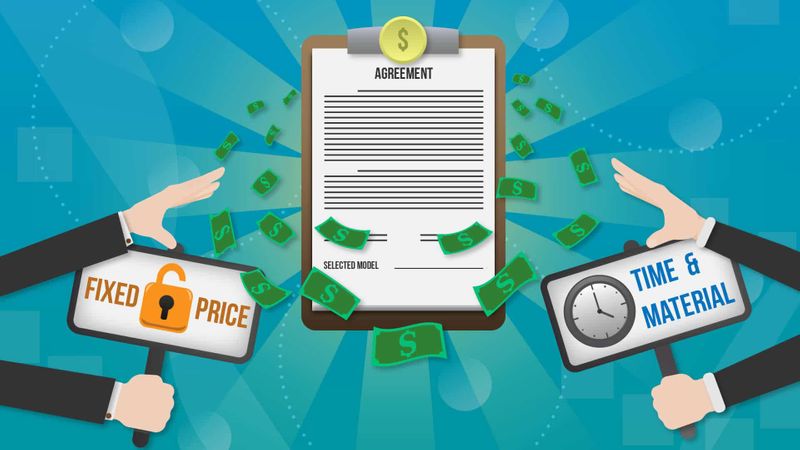Contractual Relationship in IT: What to Choose
READ WHOLE ARTICLE

The issue of payment, of course, is one of the key points in the entire product development process. There are several basic payment models, each of which has its own advantages and disadvantages, being an effective solution for some projects, and far from the best option for some.
Choosing a model of cooperation with an IT company, you should pay attention to the possibilities offered by one or another type of contract. Among the most popular payment models to date are the Time and Materials and Fixed Price contract. Here you will find out about the difference between them and the reason we recommend Time and Materials to have the desired result from the development.
Contract Models
The Fixed Price model expects that the financial plan for the development of the whole project is set before the beginning of work and stays unaltered.
It implies a full assessment of all the necessary work on the project according to the technical task provided by the client. In the end, the project deadline and cost are set and only then the whole work process is to start.
Key points you get working on Fixed Price contract:
- straight budget;
- upstanding number of tasks;
- straight time frames;
- irreversibility to change or add anything after having a deal;
- higher rates for the development;
- likely trades-off with loss in quality or time.
Time and Material (TM) means the hourly pay of hired specialists’ work on the principle of “you pay as we go”. Estimation of the scope of work, the scale of the project and the timing of its completion is carried out, but approximate, as with TM various changes often occur, and the main result is the final result and its quality, not time and price, in which it is necessary to meet any means.
Key features of the work on T&M:
- All material is cut into tasks, each of which the team evaluates apart, that’s why the client has a chance to add or change something during the working process;
- The development team evaluates the new task and provides the client with info about number of hours which are needed for its implementation;
- After the task is completed and the client got an expected result – he/she pays for the team’s work (it can be done right after the sprint, every month, once a quarter, etc. – as you agreed).
Let’s compare
As you can see, both contracts have its benefits and drawbacks which can influence your project outcome. So we decided to compare them according to the most stunning categories.
| Fixed price | Time & Material | |
| Flexibility | No | Yes |
| Despite of the fact that all functionality was discussed before the working start, the client usually needs to add or skip an option afterwards. T&M model assumes such changes with both client and executive being comfortable in it. | ||
| Risks | Taken by development team | Taken by the client |
| Companies performing on Fixed Price add extra cost in the budget in order to insure themselves against unforeseen situations. If you look tight at it – the project you get in time, but the state and cost can be argued. In order not to earn penalties, the contractor will be interested in delivering the project fast, sometimes even with the loss of quality. | ||
| Price | Not vary, but overrated | Vary but easy-to-determine |
| T & M contract involves pay upon completion of work. The project is cut into stages so it is easier to estimate timeline and determine the whole budget. | ||
| Start of working process | Slower | Faster |
Fixed price contract needs such assignments to be completed:
In T&M:
| ||
| Reporting | Less documentation | More details |
| After signing T&M contract, the client pays for hours which were spent for a specific period of time. So PM manages all the team and is responsible for the effectiveness and the performance of work. | ||
What to choose?
Everywhere there are pros and cons and some disadvantages can be minimized with good management. We can not say for sure what is best. For each project and a specific client, even for each methodology, completely different models will be applied or, perhaps, even combined.
There is a list of questions you should ask yourself before choosing a model:
These are the main issues, but in the process of reviewing each specific project there will be more. However, if you have a project and you do not know it will be our best task, as experts, to help you make a choice. |  |
How to Control Outsourcing Development Company?
Final Words
In case you have a tiny project for which definite requirements has been drawn up and you are truly certain that you won’t make changes or additions, then a fixed-rate contract may fit you. In any case, it merits being ready for possible flaws, issues and extension of the deadlines for redressing them.
For clients, who need to execute huge long-term projects, we advise not taking risks and picking an adaptable development and payment model – Time & Materials. Your idea has the privilege to be given extraordinary consideration. Regular communication, discussion of all details will help to make a product that will really solve the tasks of your target audience. So it will be viable, prominent and have the possibility of further advancement. From much practice, we observed that at the start of the development of large projects the customer seldom bears an accurate idea of all the necessary functionality.
The T & M model is optimal when it comes to software testing, the implementation of individual units of work, the creation of a medium-term project from scratch without the initial specification and the need to adapt to the demands of the client and market requirements, large projects with adjustment of work and specifications in the course of development.
T & M is characterized by flexibility of workflow and transparency of communications. As the project develops, together with you Multi-Programming Solutions goes deeper into the tasks – this is like new improvements and ideas burst out.
Contact us to discuss your idea!

36 Kings Road
CM1 4HP Chelmsford
England


